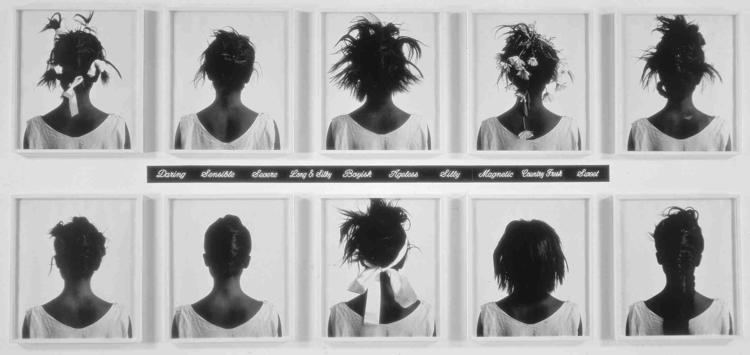Full Name Lorna Simpson Role Artist Nationality American Period Contemporary art | Name Lorna Simpson | |
 | ||
Known for Photography, Film, Video | ||
Lorna simpson
Lorna Simpson (born 1960) is an African-American photographer and multimedia artist who made her name in the 1980s and 1990s with artworks such as Guarded Conditions and Square Deal. She is one of the leading artists of her generation (to much critical acclaim), and her works have been included in numerous exhibitions both nationally and internationally.
Contents
- Lorna simpson
- Lorna simpson whitney museum of american art
- Background
- Career
- Work
- Private life
- Awards
- List of Works
- Exhibitions
- References

Lorna simpson whitney museum of american art
Background

Born in Brooklyn, New York in 1960, she attended the High School of Art and Design and the School of Visual Arts in New York where she received a Bachelor of Fine Arts in Photography. After receiving her BFA, she traveled to Europe and Africa, developing skills in documentary photography, her earliest works. While traveling, she became inspired to expand her work beyond the field of photography in order to challenge and engage the viewer.

It was these ideas that she worked on while earning her Master's of Fine Arts degree from the University of California at San Diego in 1985. Her education in San Diego was somewhere between Photography and Conceptual art, and her teachers included conceptualist Allan Kaprow, performance artist Eleanor Antin, filmmakers Babette Mangolte and Jean-Pierre Gorin and poet David Antin. What emerged was her signature style of "photo-text", in which graphic text is inserted into studio-like portraiture, bringing new conceptual meaning into the works. These works generally related to the perception of African-American women within American culture.
Career

Throughout the 1980s and 1990s, Simpson was showing work through solo exhibitions all over the country, and her name was synonymous with photo-text artworks. She was awarded a National Endowment for the Arts Fellowship in 1985, and in 1990, she became the first African-American woman to exhibit at the Venice Biennale. In 1990, Simpson had one woman exhibitions at several major museums, including the Denver Art Museum, Denver, Colorado, the Portland Art Museum, Portland, Oregon, and the Museum of Modern Art, New York. Simpson has explored various media and techniques, including two-dimensional photographs as well as silk screening her photographs on large felt panels, creating installations, or producing as video works such as Call Waiting (1997).

By the 2000s she had started exploring the medium of video installations in order to avoid a paralysis brought on by outside expectations. In 2001 she was awarded the Whitney Museum of Art Award, and in 2007, her work was featured in a 20-year retrospective at the Whitney Museum of Art in New York City.
Simpson continues to influence the legacy of black artists today by speaking with artists and activists such as the Art Hoe Collective, a group of young women using social media to give marginalized groups a safe platform to broadcast their artwork.
In 2016 Simpson created the album artwork for Black America Again by Common. During the same year, she was featured in the book In the Company of Women, Inspiration and Advice from over 100 Makers, Artists, and Entrepreneurs. In a 2017 issue of Vogue Magazine, Simpson showcased a series of portraits of 18 professional creative women who hold art central to their lives. The women photographed included Teresita Fernández, Huma Bhabha, and Jacqueline Woodson. Inspired by their resilience, Simpson said of these women, "They don't take no for an answer".
Simpson's work has been displayed at the Museum of Modern Art, the Museum of Contemporary Art, the Miami Art Museum, the Walker Art Center, the Minneapolis Institute of Art, and the Irish Museum of Modern Art. In 2007, Simpson had a 20-year retrospective of her work at the Whitney Museum of American Art in her hometown of New York City.
Work
Simpson first came to prominence in the 1980s for her large-scale works that combined photography and text and defied traditional conceptions of sex, identity, race, culture, history, and memory. Drawing on this work, she started to create large photos printed on felt that showed public but unnoticed sexual encounters. Recently, Simpson has experimented with film as well as continuing to work with photography.
Simpson's 1989 work, Necklines, shows two circular and identical photographs of a black woman's mouth, chin, neck, and collar bone. The white text, “ring, surround, lasso, noose, eye, areola, halo, cuffs, collar, loop”, individual words on black plaques, imply menace, binding or worse. The final phrase, text on red “feel the ground sliding from under you,” openly suggests lynching, though the adjacent images remain serene, non-confrontational and elegant.
Easy for Who to Say, Simpson's work from 1989, displays five identical silhouettes of black women from the shoulders up wearing a white top that is similar to women portrayed in other of Simpson's works. The women's faces are obscured by a white-colored oval shape each with one of the following letters inside: A, E, I, O, U. Underneath the corresponding portraits are the words: Amnesia, Error, Indifference, Omission, Uncivil. In this work Simpson alludes to the racialization in ethnographic cinema and the revocation of history faced by many people of color.
Simpson's work Guarded Conditions, created in 1989, was one in a series in which Simpson has assembled fragmented Polaroid images of a female model whom she has regularly collaborated with. The body is fragmented and viewed from behind, while the back of the model's head is sensed as being in a state of guardedness towards possible hostility she can anticipate as a result of the combination of her sex and the color of her skin. The complex historical and symbolic associations of African-American hairstyles are also brought into play. The message of the text and the formal treatment of the image reinforce a sense of vulnerability. The fragmentation and serialization of bodily images disrupts and denies the body's wholeness and individuality. In attempting to read the work the viewer is provoked into confronting histories of appropriation and consumption of the black female body.
Simpson's work often portrays black women combined with text to express contemporary society's relationship with race, ethnicity and sex. In many of her works, the subjects are black women with obscured faces, causing a denial of gaze and the interaction associated with visual exchange. Through repetitive use of the same portrait combined with graphic text, her "anti-portraits" have a sense of scientific classification, addressing the cultural associations of black bodies.
In a 2003 video installation, Corridor, Simpson sets two women side-by-side; a household servant from 1860 and a wealthy homeowner from 1960. Both women are portrayed by artist Wangechi Mutu, allowing parallel and haunting relationships to be drawn. She has commented, "I do not appear in any of my work. I think maybe there are elements to it and moments to it that I use from my own personal experience, but that, in and of itself, is not so important as what the work is trying to say about either the way we interpret experience or the way we interpret things about identity."
Private life
Simpson lives in Brooklyn with her daughter Zora.
Awards
List of Works
lll (Three Wishbones in a Wood Box). 1994. wooden box containing three wishbones made of ceramic, rubber and bronze inserted in two felt pads. Minneapolis Institute of Art.
Back. 1991. 2 colour Polaroids and 3 plastic plaques.
Counting. 1991. photogravure and screenprint. Minneapolis Institute of Art.
Five Day Forecast. 1991. 5 photographs, gelatin silver print on paper and 15 engraved plaques. Tate Modern, London. [1]
Untitled (What should fit here...). 1993. photo-etching, screenprint and hand-applied watercolor. Minneapolis Institute of Art.
The Waterbearer. 1996. silver print.
Wigs (Portfolio). 1994. portfolio of twenty-one lithographs on felt with seventeen lithographed felt text panels. Museum of Modern Art, New York City.
Exhibitions
The Whitney Museum of American Art in New York, NY, held a retrospective of Simpson's work in 2007.
The Elizabeth A. Sackler Center for Feminist Art at the Brooklyn Museum presented a solo exhibition of Simpson's work, "Lorna Simpson: Gathered," in 2011.
The Galerie nationale du Jeu de Paume organized the first European retrospective of Simpson's work in 2013, which traveled to the Baltic Centre for Contemporary Art in 2014.
Beginning in 2008, Simpson's work, Wigs (Portfolio), was included in the exhibition, "30 Americans," which has toured eleven locations to date, including the Rubell Family Collection, Miami, North Carolina Museum of Art, Corcoran Gallery of Art, Chrysler Museum of Art, Milwaukee Art Museum, Frist Center for the Visual Arts, Contemporary Arts Center (New Orleans), Arkansas Arts Center, Detroit Institute of Arts, Cincinnati Art Museum, and Tacoma Art Museum.
